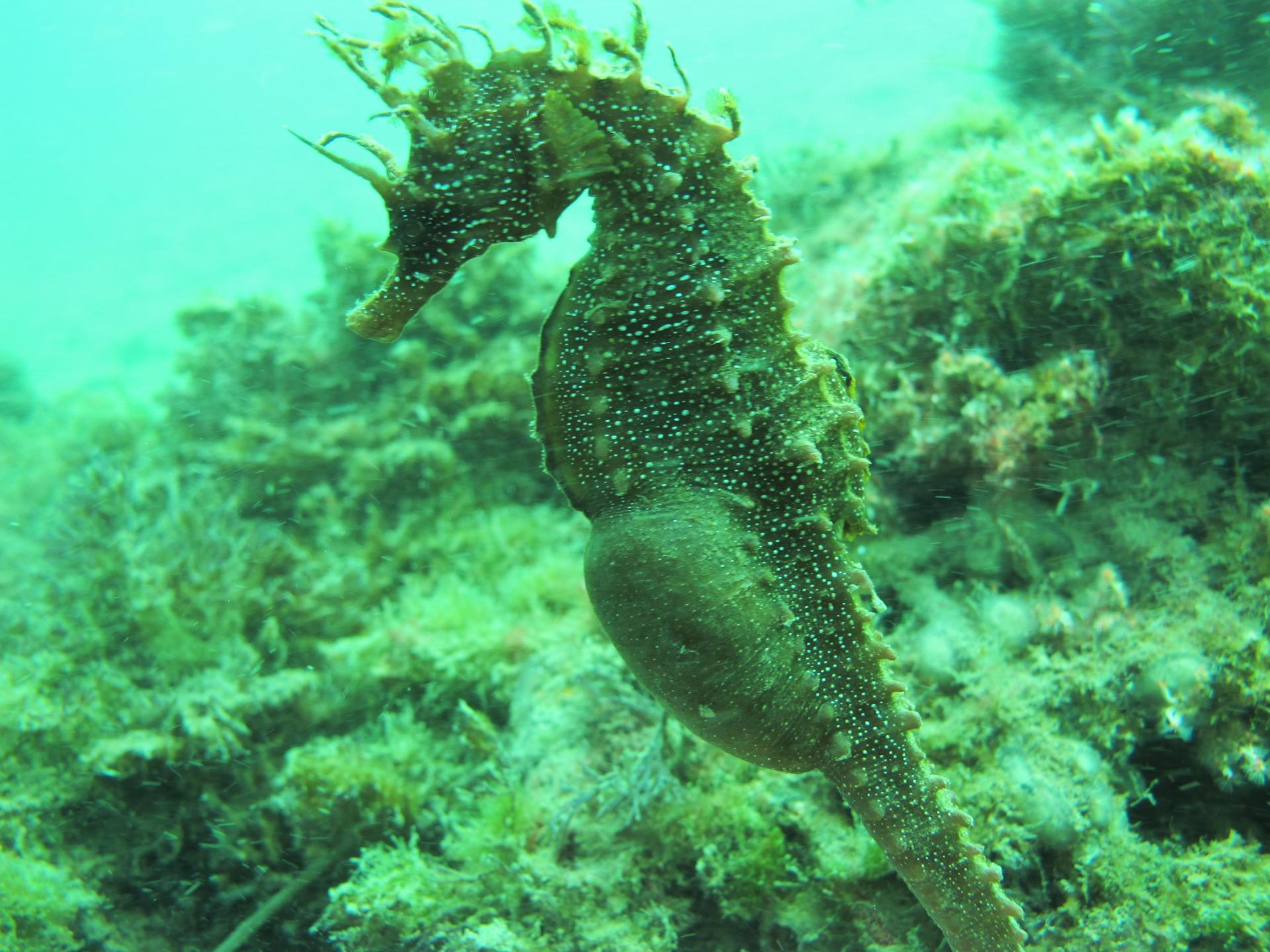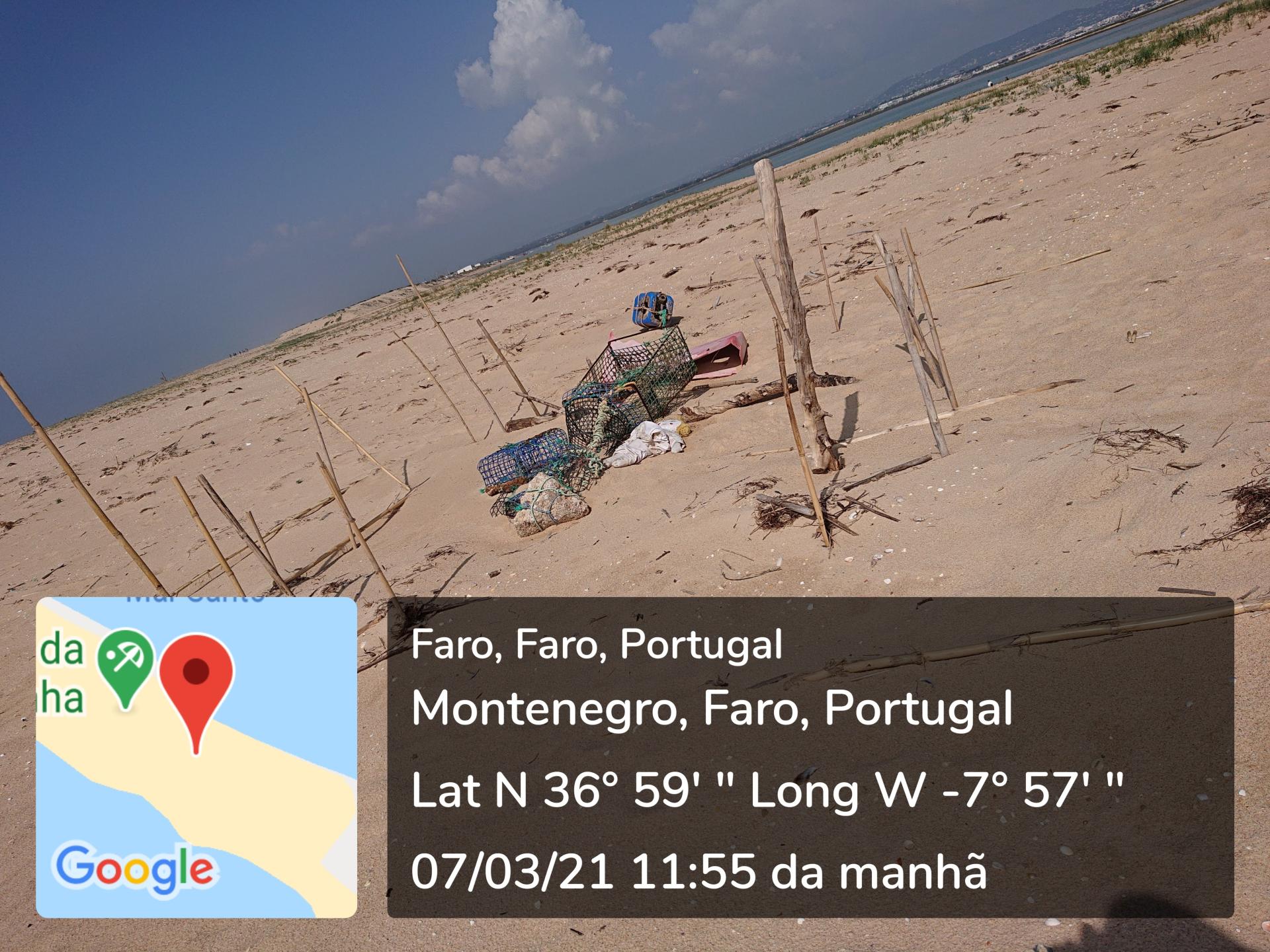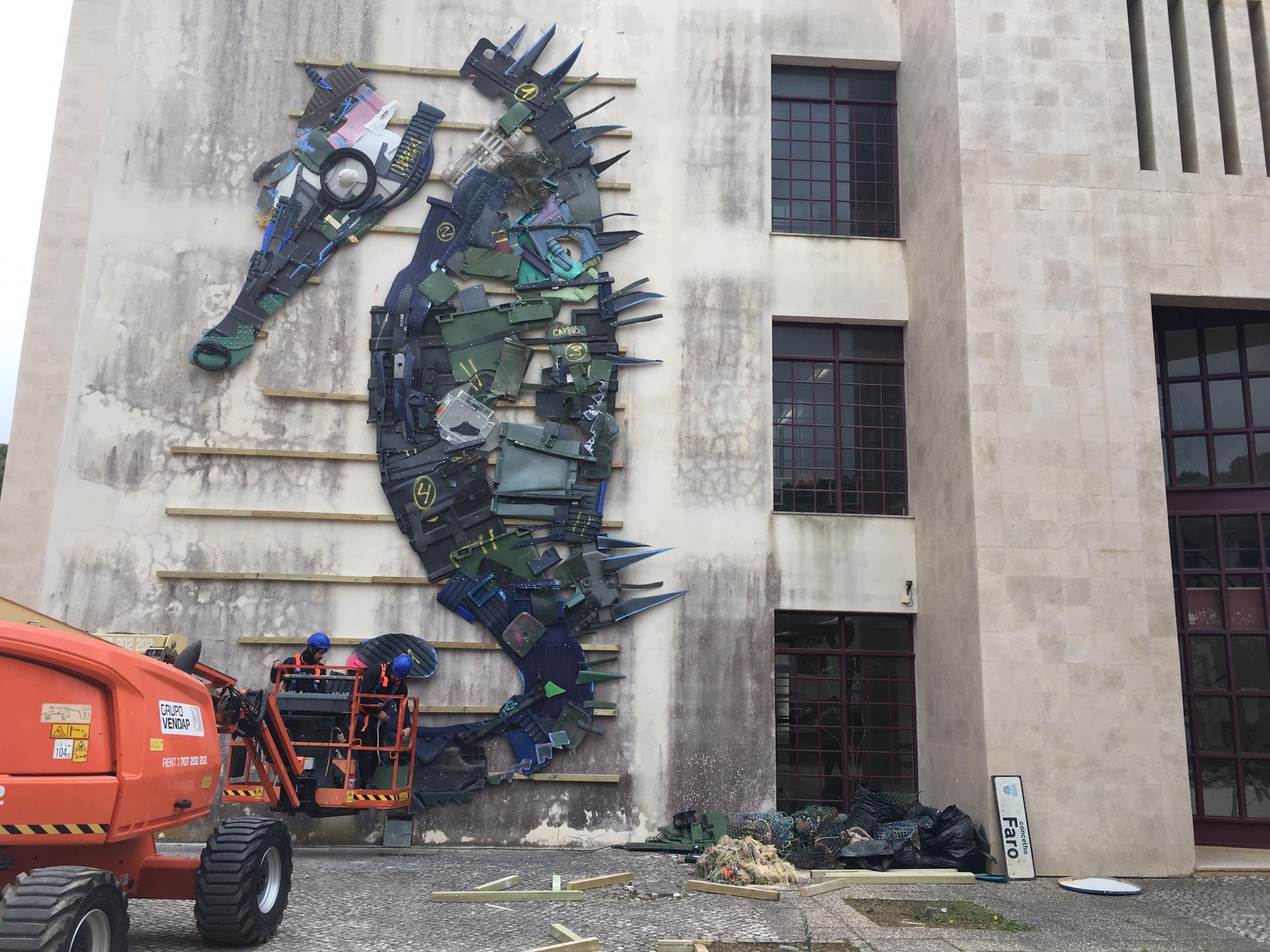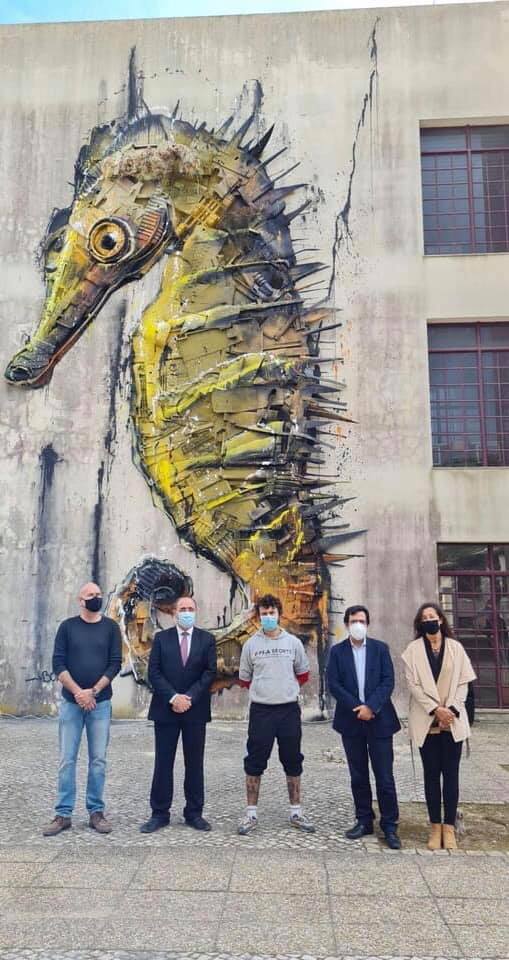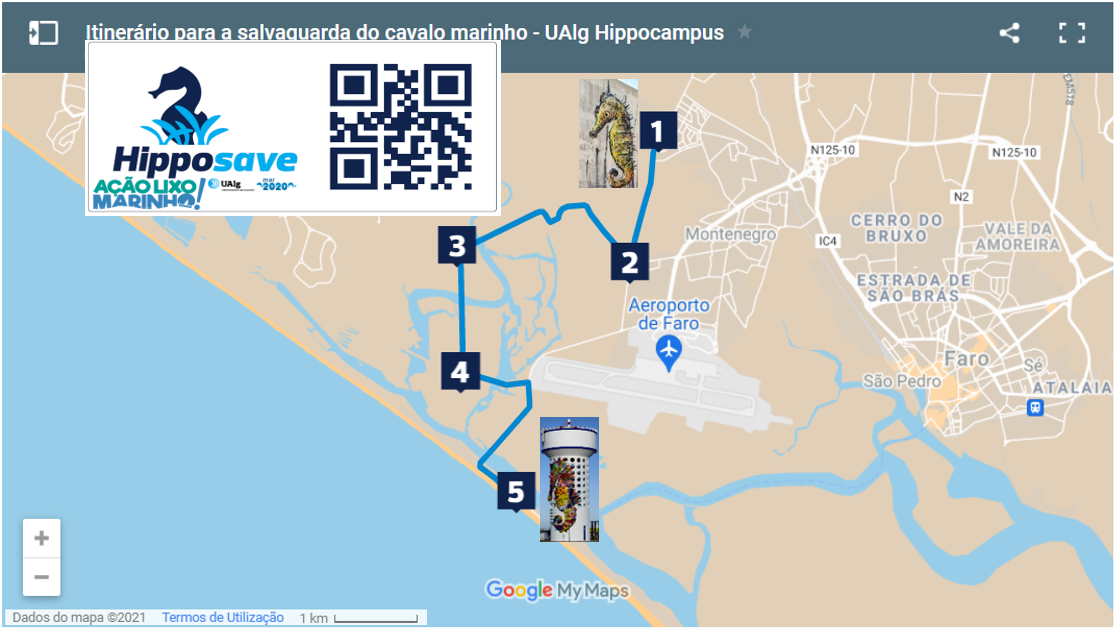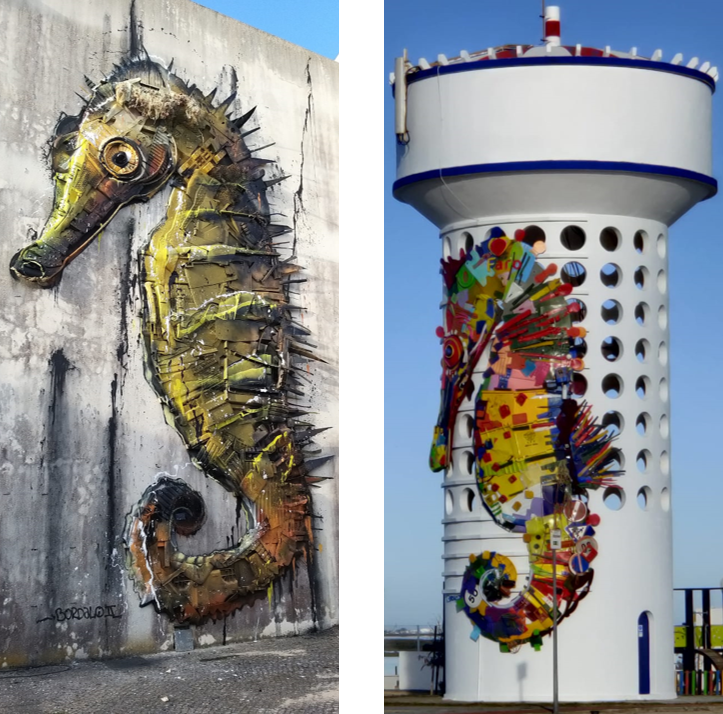SeaHorse Itinerary - HIPPOCAMPUS
Basic information
Project Title
Full project title
Category
Project Description
The Itinerary aims to seed the Culture of the Bauhaus of the Seas in the University of Algarve and surrounding communities anchored in the Ria Formosa-Coastal Lagoon. This was fostered by an interdisciplinary project, bound artists, managers, and scientists around the preservation of an iconic species the SeaHorse-Hippocampus and its habitat the seagrasses threatened by anthropogenic and climate changes. In this reinvented place citizens may share a reconciling attitude with the sea-nature righs
Project Region
EU Programme or fund
Which funds
Other Funds
HIPPOSAVE - Action plan to recover Sea Horse in Ria Formosa EUROPEAN MARITIME & FISHERIES FUND "MAR 2020" aims to implement in Portugal the support measures under the European Maritime and Fisheries Fund (FEAMP) and its Strategic Priorities include: Promote competitiveness based on innovation and knowledge.
ALIMAR – Marine litter Action! (FA_06_2017_081), supported by Portuguese "Fundo Azul do Ministério do Mar"
Description of the project
Summary
The itinerary UAlg-HIPPOCAMPUS for SeaHorse conservation aims to reinvent ways to meet and share, in situ, with citizens how:i) it is possible to promote sustainability (with the focus on circularity), using marine litter, mainly plastics, to produce pieces of art; ii)to admire the beauty of marine biodiversity with the esthetic of an iconic sea animal “The SeaHorse “in the Big Trash Animals Collection by Bordalo II and iii)to make accessible to all (students, local residents, and tourists) a simple itinerary, walking or by bike, guided by our QR codes creating awareness of threatened species in Ria Formosa and the importance of marine biodiversity for EU Green Deal. The itinerary starts in the University of Algarve -UAlg where knowledge has been produced about marine life and continuing during 8 km crossing the natural reserve Ria Formosa where the target species has its habitat threatened by human behavior not only illegal fished and abandoned gears but also several types of plastic detritus also negatively affect the valuable seagrass area, a blue infrastructure to absorb CO2. This itinerary is a real interdisciplinary project that was built with the co-production of scientists from fields as Marine Biology, Conservation, Engineering, Chemistry, and Social Sciences and effective contribution of Citizen Science and Volunteering NGO, that regularly organize cleaning actions of the coastal area where marine litter is collected. The expected outcome is an increasing awareness of the need to respect nature rights and an effective contribution to the EU GREEN DEAL. This will be achieved by incentivizing the reduction of plastic use and disposal, which will lower CO2 emissions, directly and indirectly, due to the potential recovery of seagrass bed, that also naturally absorbs 200 mil ton CO2 only in Ria Formosa (30% CO2 sinkers in all similar ecosystems-Portugal) and those are also indispensable habitat for seahorse conservation. UAlg Hippocampus | University of Algarve
Key objectives for sustainability
The itinerary develops on coastal areas near UAlg. This protected area with seagrass habitat is threatened by climate change and by human behavior not only by illegal fisheries and abandoned gears but also daily used plastic that will fragment and reaching the watercourses contributing cumulatively as SeaHorses threats.Nature rights are one challenge that society faces with complex and multidimensional axes, leading to new paradigms associated with sustainable development. To be promoters of change, the 21st-century UAlg produces solid scientific knowledge and, most importantly, hold the capacity to incorporate it in order to understand the interactions between global, natural, social, and human systems, and how such interactions affect the sustainability contests. The SeaHorse Itinerary assimilated knowledge and mastery of tools from natural sciences, from engineering and arts, that are seldom addressed by individual disciplines to present this project as an integrated approach. Today, disciplinary science deeply contributes to understanding the function of the various pieces that make up our world but has gaps in understanding how these parts relate to each other. UAlg addresses this challenge of Sustainability Science by offering: an innovative action that pursues interdisciplinarity, the application of science to real problems, and the integration of knowledge and innovation with the participation of society and citizens. The SeaHorse Itinerary connects two pieces of art (BIG Trash Animal collection (Bordalo II) built with the contribution of marine litter collected by citizens. With actions as this one and in agreement with UAlg strategic plan for 2017-2021 we aim to be convergent with the United Nations 2030 agenda for sustainable development, through an institution committed to society, reconnecting communities with their habitats and forms of material, ecological, aesthetic and cultural heritage, supporting the generation and co-creation of innovative ideas
Key objectives for aesthetics and quality
This hybrid space joining nature and attention to anthropogenic threats aims to be a reinvented area where citizens meet while doing exercise and being healthy, using nature and art as the mobilisation action. The two large-scale pieces of art the sea horses that are connected in Faro by this itinerary are the most recent creation of Artur Bordalo, artistic name Bordalo II.Born in 1987 he saw in his grandfather, the painter Real Bordalo, his great source of inspiration to become a plastic artist or "artivist" as he defines himself. He creates and recreates from our garbage, here from marine litter. The SeaHorses pieces, inaugurated on April 9 2021, where the artist uses plastic discarded materials, as raw material, including abandoned fish gears recovered by volunteers in the Ria Formosa, during clean beach action (ALIMAR project, V+; STRAW PATROL, CMFaro). To the assemblage layers of paint, some smoky, brushstrokes, drips and splashes are added until the expressiveness of the represented animal and its natural colors are achieved. The goal was to generate representations of the animals almost in such a way as to camouflage what destroys them and create a more realistic image.In addition to the SeaHorse work in Gambelas campus, another one was built in the water tank of the Camping Park of Praia de Faro, also included in the series "Big Trash Animals". The Seahorses are subject to various threats, from illegal harvesting for export to the Asian market, accidental fishing, climate change, and habitat degradation. These factors have contributed to the fact that the SeaHorses population has declined dramatically in Ria Formosa, hence the need to raise awareness about the importance of preserving the species. Beyond the aesthetic value of the pieces, they also attract attention to the coastal lagoon as a natural blue infrastructure that protects us against climate change, while giving people access to nature to promote their physical/mental health.
Key objectives for inclusion
The possibility of admiring the beautiful is also an inclusive approach to society. This project aims to make accessible to all (students, local residents and tourists) a simple itinerary, walking or by bike, guided by our QR codes creating awareness of the importance of marine biodiversity and EU Green Deal in a close coastal ecosystem the Ria Formosa. The itinerary for the conservation of the seahorse was named by its scientific genus Hippocampus. The COVID-19 pandemic reminds us that the health of all is vulnerable to immediate threats emerging from the ecosystems we inhabit. More insidious global threats include the increasing consequences of climate change, biodiversity loss, and pollution. As the largest connected ecosystem on Earth, the global ocean exerts a greater influence than any other on our climate and weather, affecting global food production and international trade. Much more importantly, human health is intricately linked to “ocean health.”The United Nations has announced the Decade of Ocean Science for Sustainable Development from 2021 to 2030.The itinerary between the two large-scale pieces of art, call for a revitalized, inclusive endeavor to repair the damage we have done during our careless past and to protect the myriad benefits available in the future. It is necessary co-production science citizen science on delivering a resilient, sustainable ocean that fosters improvements in public and marine ecosystem health. The QR codes will call attention to the sea importance in tackling global solutions for carbon capture (marine grasslands, plankton, clams), and offer great potential in renewable energies, sustainable transport, food, and biomaterials, and biotechnologies. The ocean faces strong threats regarding pollution (plastics) and ecosystem degradation in face of climate change (erosion, sea-level rise) but coastal areas as Ria Formosa provide a space for future intervention where we can avoid unforeseen mistakes made in past instances.
Results in relation to category
The expected impact of the project is an increasing awareness of each individual to the need of respect to nature rights and an effectively contribution to the EU GREEN DEAL. This will be achieved by incentivize the reduction of plastic disposal, found in messages of our QR codes in the itinerary, that will contribute to mitigate CO2 emissions directly and indirectly due to potential recovery of seagrass beds, that also natural absorb 200 mil ton CO2 only in Ria Formosa (30% CO2 sinkers in all similar ecosystems in Portugal) and those are also indispensable habitat for seahorse conservation. The involving affected communities and stakeholders in participatory governance to develop local solutions to the issues they face is very valuable and will attract more people to the area. The personal meaning of the challenges that communities face and the sense of personal vulnerability can generate greater awareness and create engagement.
The project HIPPOSAVE targeting the conservation of the Ria Formosa SeaHorses made possible to protect some of the identified areas as essential for population recover, and now they have already an reinforce status of protection (marine protected areas-MPA). Nevertheless to show these tiny and vulnerable underwater animals to common citizen and the need of those MPA it is not easy. So this itinerary allows a non-diving citizen the opportunity to observe and to honor this amazing beautiful of marine biodiversity by the observation of their habitats and esthetic this iconic sea animal with the pieces of art “Big Trash Animals Collection- Bordalo II”. The symbology to have an health community of Seahorses in Ria Formosa will be the major result when citizen understood that this is equivalent to an healthy coastal ecosystem to all. The project ALIMAR had bring educational activities and community involvement, impacting awareness of citizen in the conservation of these coastal areas and stimulate responsible consumption habits.
How Citizens benefit
The UAlg -Hippocamus Itinerary was built with the direct involvement of civil society. It started with cleaning beaches actions, involving the team of the project Alimar and the volunteer groups of students and professors from UAlg V+ (University Volunteering group-V+) and local NGOs-STRAW PATROL, Environmental Regional Public institute-APA-ARHalg – Environmental Volunteering for Water, Faro Municipality Sport Group. The pieces of art built in Gambelas and in Faro island, were created by the artist BORDALO II, but with the marine litter collected by those citizen groups. Those citizens and many more will be benefiting from the project (not only students from UAlg levels, university, primary and secondary schools and regional communities, but also UAlg visitors and national and international tourists). This hydrid space joining nature and attention to anthropogenic threats aims to be a reinvented area where citizen meet while doing exercise and being healthy, using nature and art as the mobilisation action. Success can only be achieved by instilling proenvironmental behavior at individual and community levels and by involving affected communities and stakeholders in participatory actions to develop local solutions to the issues they face and generate greater awareness and commitment with the EU GREEN DEAL. UAlg results in the Times Higher Education THE IMPACT show our contribution in Sustainable Development Goals (SDGs), (4, 5,9,10,11,14,16), demonstrate UAlg's contribution to the new global challenges of sustainability, such as education for all with quality, reducing inequalities including gender, innovation, sustainable economic growth, aquatic life protection. This demonstrates the commitment to inclusive education, as well as lifelong learning, with innovative teaching techniques as this informal one, where the itinerary fits to educate to respect the valorization of nature by itself and by the benefit that brings to our health.
Innovative character
UAlg addresses this challenge of Sustainability Science by offering: an innovative action that pursues interdisciplinarity, the application of science to real problems, and the integration of knowledge and innovation with the participation of society and citizens. This itinerary is a real interdisciplinary project targeting environmental sustainability that was built with the knowledge of scientists from fields as Marine Biology, Conservation, Environmental Engineering, Chemistry, and Social Sciences and effective contribution of Citizen Science and Volunteering NGO, that regularly organize cleaning actions of the coastal area. The itinerary “For the conservation of SeaHorse” aims to invent places to meet and share, in situ, with citizens awareness of the need to reduce marine litter that will be ending in the sea and threatening SeaHorses life and habitat, as the seagrasses in Ria Formosa, a real blue infrastructure to absorb CO2 and contribute to the EU Green Deal. The lockdowns during the current pandemic have been a vivid reminder of our huge reliance on being able to visit natural settings, in particular coastal areas, for health and well-being. Studies over the past 10 years have demonstrated that spending time in high-quality “blue” spaces (through leisure activities or living in a coastal environment) directly supports and enhances health and well-being, combatting obesity and mental health problems, particularly in deprived populations. UAlg -Hippocampus Itinerary is an innovative approach contributing to the well-being of the population and increasing awareness of the consequences of their individual behaviors concerning marine litter and the knowledge about marine ecosystems surrounding us, including endangered's iconic species such as the SeaHorse. Much more needs also to be shared with the citizen in an innovative way, for example, Seafood provides a source of micronutrients and omega-3 fatty acids essential for good physical and mental health.

